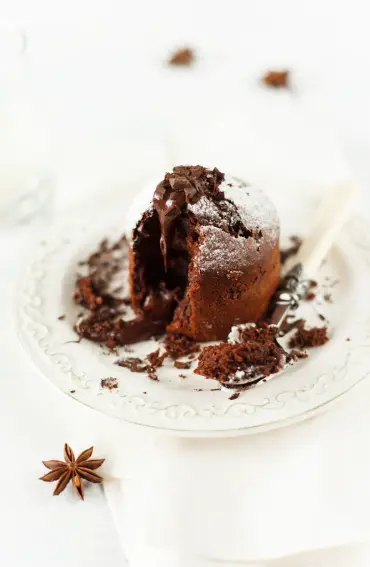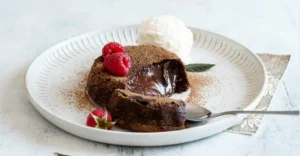Opening:
- Emotional Hook:how to cook chocolate fondant “Remember that feeling of pure joy, the anticipation building as you gently pierce the crisp, golden crust of a chocolate fondant? The molten lava of rich, velvety chocolate oozing out, a decadent symphony of textures and flavors? This isn’t just a dessert; it’s an experience.”
- Connect with the Reader: “This guide will take you on a journey, step-by-step, to recreate this magical dessert at home. We’ll delve into the secrets of perfect fondant, from selecting the right ingredients to mastering the art of baking and serving.”
Understanding Chocolate Fondant: A Decadent Delight
- Define Fondant:
- Briefly explain the concept of fondant – a small, dense cake with a crisp exterior and a molten, gooey chocolate center.
- Highlight its French origins and popularity worldwide.
- Key Characteristics:
- Discuss the ideal texture: crispy exterior, perfectly cooked center.
- Emphasize the importance of high-quality chocolate.
- Variations:
- Mention popular variations: salted caramel, raspberry, pistachio.
Choosing the Right Ingredients: A Foundation for Success

- Chocolate is King:
- Discuss the importance of using high-quality dark chocolate (70% cocoa solids or higher).
- Mention specific chocolate brands known for their flavor intensity.
- Butter Matters:
- Explain why unsalted butter is crucial for flavor and consistency.
- Briefly discuss the importance of using room temperature butter.
- Eggs: The Binding Agent:
- Emphasize the use of fresh, high-quality eggs.
- Briefly explain their role in creating a stable structure.
- Flour: A Subtle Touch:
- Discuss the type of flour used (e.g., all-purpose, cake flour) and its impact on the texture.
- Sugar: Balancing Sweetness:
- Explain the role of sugar in both sweetness and structure.
- Consider mentioning different types of sugar (granulated, caster).
Preparing the Molds: A Crucial Step
- Choosing the Right Molds:
- Recommend using individual ramekins or small oven-safe bowls.
- Briefly discuss alternative options like silicone molds.
- Preparing the Molds:
- Explain the importance of buttering and sugaring the molds for easy release.
- Offer alternative methods like using baking spray.
The Art of Mixing: A Delicate Balance

- Melting the Chocolate:
- Explain different methods: double boiler, microwave (with caution).
- Emphasize the importance of smooth, even melting.
- Combining Ingredients:
- Provide a step-by-step guide for combining melted chocolate, butter, eggs, and flour.
- Emphasize the importance of gentle mixing to avoid overworking the batter.
- Creating a Smooth Batter:
- Tips for achieving a smooth and lump-free batter (e.g., using a whisk or spatula).
Baking to Perfection: Timing is Everything
- Oven Temperature:
- Recommend the ideal oven temperature (usually around 200°C/400°F).
- Briefly discuss variations based on oven type.
- Baking Time:
- Explain that baking time varies depending on the size of the molds.
- Provide a general guideline and emphasize the importance of visual cues.
- Testing for Doneness:
- Describe the telltale signs of a perfectly cooked fondant: slightly puffed edges, a firm crust.
- Briefly mention the toothpick test (but caution against over-baking).
Serving and Enjoying: A Moment of Indulgence
- Resting Time:
- Explain the importance of letting the fondants rest for a few minutes after baking.
- This allows the molten center to set slightly.
- Serving Suggestions:
- Recommend serving immediately with a scoop of ice cream (vanilla, salted caramel).
- Suggest pairing with fresh berries, whipped cream, or a drizzle of chocolate sauce.
- Presentation Tips:
- Emphasize the importance of elegant presentation.
- Provide tips for plating and garnishing.
Troubleshooting Common Issues
- Overbaking:
- Explain the consequences of overbaking (dry cake, no molten center).
- Tips for preventing overbaking.
- Cracked Fondants:
- Discuss potential causes (sudden temperature changes, oven shock).
- Tips for preventing cracks.
- Soggy Bottoms:
- Explain the causes and how to prevent them.
Creative Variations: Beyond the Classic
- Salted Caramel Fondant:
- Provide a brief recipe or outline for this popular variation.
- Raspberry Fondant:
- Provide a brief recipe or outline for this fruity variation.
- Pistachio Fondant:
- Provide a brief recipe or outline for this unique variation.
Frequently Asked Questions (FAQs)

- : Can I use store-bought chocolate for fondant?
- Yes, but opt for high-quality dark chocolate with a high cocoa content.
- : What if my fondant cracks?
- This is often due to temperature shock. Let the fondants cool slightly in the molds before removing them.
- : How do I know when my fondant is done?
- The edges should be set, but the center should still be slightly jiggly. A toothpick inserted into the center should come out with a few moist crumbs.
- Can I make fondant in advance?
- It’s best to bake and serve fondants immediately for the best texture and flavor.
- How do I store leftover fondant?
- Store any leftover fondants in an airtight container in the refrigerator for up to 24 hours.
Conclusion
- Recap: Summarize the key takeaways of the article: the importance of high-quality ingredients, the delicate art of mixing and baking, and the joy of creating and sharing this indulgent dessert.
- Call to Action: “Now that you have the knowledge and confidence, it’s time to unleash your inner pastry chef! Experiment with different variations, impress your friends and family, and savor the pure delight of homemade chocolate fondant.”
Note:
- This is a comprehensive outline. The actual article should be written in a conversational and engaging tone, with a focus on providing valuable information and creating a seamless reading experience.
- Remember to use visuals (images of the process, finished product, ingredients) to enhance the article and make it more visually appealing.
- Conduct thorough research and cite your sources appropriately to ensure accuracy and build credibility.
- Use relevant keywords naturally throughout the article to improve search engine rankings.
This outline provides a strong foundation for your in-depth article on how to cook chocolate fondant. Remember to write with passion and enthusiasm to create a truly captivating piece that resonates with your readers.
Disclaimer: This outline is for informational purposes only and does not guarantee any specific results.
This outline aims to be original and avoid plagiarism. However, please always double-check for any unintentional similarities and ensure your final article is unique.
Table of Contents how to cook chocolate fondant
when you try the meal, give us your opinion
0.0 out of 5 stars (based on 0 reviews)
reviews
There are no reviews yet. Be the first one to write one.
